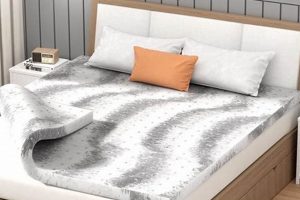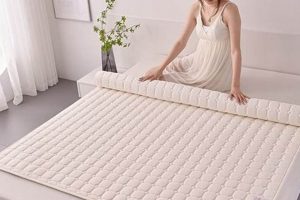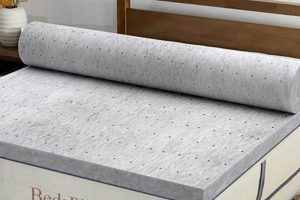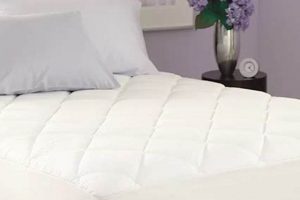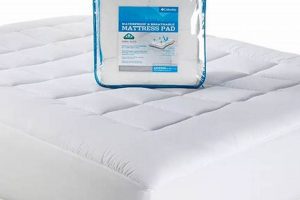A convoluted foam overlay, typically polyurethane, designed to add a layer of cushioning to an existing bed. The surface is characterized by a series of raised peaks and recessed valleys, resembling the structure of a container used for storing fragile ovoids. This design aims to distribute weight and enhance airflow beneath the sleeper.
The primary advantages of such products include improved comfort, pressure relief, and enhanced breathability compared to flat foam alternatives. The unique surface contours promote air circulation, potentially reducing heat buildup during sleep. These mattress enhancements offer an economical solution for those seeking to improve their sleep surface without investing in a completely new mattress, gaining popularity due to their affordability and ease of use.
Subsequent discussion will elaborate on the material composition, density options, size variations, and the recommended applications for this type of bedding accessory. Considerations for proper care, cleaning, and lifespan expectancy will also be addressed to provide a thorough understanding of its practical use and maintenance.
Optimizing Comfort and Longevity
This section provides guidance on maximizing the benefits and extending the lifespan of a convoluted foam bedding enhancement. Proper utilization and maintenance are crucial for achieving optimal comfort and hygienic sleep conditions.
Tip 1: Selection Based on Density. Examine density ratings prior to purchase. Higher density materials generally provide enhanced support and durability, while lower densities may compress more rapidly, reducing overall lifespan.
Tip 2: Addressing Odor Concerns. New units may exhibit a noticeable chemical odor. Air the product outdoors, in a well-ventilated area, for 24-48 hours prior to initial use to dissipate these volatile compounds.
Tip 3: Correct Orientation for Placement. Ensure proper orientation when positioning the overlay. The convoluted surface should face upwards, contacting the sleeper directly. Inverted placement negates the intended airflow and pressure distribution benefits.
Tip 4: Mattress Compatibility Assessment. Evaluate the suitability of the overlay with the underlying mattress. Very soft mattresses may not provide adequate support, diminishing the effectiveness of the convoluted foam. A firmer foundation is generally recommended.
Tip 5: Rotation Schedule for Even Wear. Implement a periodic rotation schedule (e.g., every 3-6 months) to promote even wear. Rotating the topper end-to-end distributes stress and prevents localized compression.
Tip 6: Gentle Cleaning Protocols. Employ gentle cleaning methods. Spot clean with mild detergent and water; avoid harsh chemicals or excessive moisture. Allow thorough air drying to prevent mold or mildew growth.
Tip 7: Protective Cover Utilization. Utilize a breathable mattress protector to safeguard against spills, stains, and dust mites. This barrier extends the topper’s lifespan and maintains a hygienic sleep environment.
Adherence to these recommendations can significantly improve user satisfaction, maintain a hygienic sleeping surface, and extend the usable life of this bedding product.
The subsequent section will delve into the potential health considerations and limitations associated with use, offering a balanced perspective on the overall value proposition.
1. Pressure Point Relief
The convoluted surface of a so-called “egg carton foam mattress pad” is intrinsically linked to its ability to provide pressure point relief. The peaks and valleys of the foam create a non-uniform surface that alters the distribution of body weight. Instead of a flat, continuous contact area, the body interacts with the topper at specific points. This reduces concentrated pressure on prominent areas such as the hips, shoulders, and spine, potentially alleviating discomfort.
The effectiveness of this pressure redistribution is directly influenced by the density and thickness of the foam. Higher density materials offer greater resistance to compression, maintaining their form and providing consistent support. Thicker toppers provide a greater buffer between the body and the underlying mattress, maximizing the potential for pressure relief. For instance, an individual experiencing lower back pain may find that a thicker, higher density convoluted foam pad reduces pressure on the lumbar region, leading to improved comfort and reduced pain during sleep. The degree of relief is also related to body weight; heavier individuals may require thicker, denser pads to achieve optimal pressure reduction.
In summary, the pressure point relief afforded by this type of mattress overlay is a direct consequence of its unique surface geometry and material properties. While it offers a cost-effective means of improving sleep comfort, its effectiveness is contingent upon selecting the appropriate density and thickness based on individual needs and body weight. The long-term durability and consistent performance of the pad in providing pressure relief also depend on proper maintenance and usage. Understanding this connection is crucial for consumers seeking to address pressure-related sleep discomfort through affordable bedding solutions.
2. Air Circulation
The defining feature of the so-called “egg carton foam mattress pad” its convoluted surface directly contributes to enhanced air circulation compared to flat foam alternatives. The alternating peaks and valleys create channels that facilitate airflow both underneath and around the sleeper’s body. This increased airflow promotes the dissipation of heat and moisture, mitigating the common issue of heat buildup that can disrupt sleep. For instance, individuals prone to night sweats or those living in warmer climates may find that this design improves their sleep quality by maintaining a cooler and drier sleeping surface.
The effectiveness of this air circulation is contingent upon several factors. The density and type of foam material influence breathability; open-cell foams generally exhibit better airflow than closed-cell varieties. Furthermore, the design of the convolutions plays a role; deeper and wider channels provide more substantial airflow. A practical example is the use of these toppers in hospitals to aid in pressure relief for patients who are bedridden, where minimizing skin moisture is critical to preventing bedsores. The increased ventilation helps to regulate skin temperature and reduce the risk of maceration.
In summary, the convoluted surface of an “egg carton foam mattress pad” actively promotes air circulation, leading to a cooler and drier sleep environment. Understanding this design principle allows consumers to make informed choices, particularly when addressing issues of temperature regulation during sleep. While other factors such as room temperature and bedding mat
erials also influence sleep climate, the enhanced ventilation provided by these toppers offers a tangible benefit in promoting comfort and restful sleep. This feature is particularly valuable for individuals susceptible to overheating or excessive sweating during the night.
3. Density Variations
Density is a critical factor determining the performance characteristics of convoluted foam mattress overlays. Measured in pounds per cubic foot (PCF), density dictates the firmness, support, durability, and overall lifespan. Variations in density directly impact the feel and suitability for different individuals and sleeping preferences.
- Low-Density Foam (1.0 – 1.5 PCF)
Low-density overlays offer minimal support and are primarily used for cushioning. They compress easily, reducing their effectiveness for heavier individuals or those requiring significant pressure relief. These are typically the least expensive options and may be suitable for infrequent use or as a temporary solution. An example of use would be for adding slight comfort to a guest bed.
- Medium-Density Foam (1.5 – 2.5 PCF)
Medium-density overlays strike a balance between comfort and support. They provide more effective pressure relief than low-density options and exhibit better durability. This density range is suitable for a wider range of body weights and sleeping positions. For instance, individuals seeking moderate comfort enhancement without excessive firmness might opt for a medium-density overlay.
- High-Density Foam (2.5 PCF and Above)
High-density overlays offer maximum support and durability. They resist compression and maintain their shape over time, making them suitable for heavier individuals and those requiring substantial pressure relief. While generally more expensive, high-density options provide the longest lifespan and consistent performance. Consider their use for those with chronic back pain or those who require substantial support due to weight.
In conclusion, the selection of an “egg carton foam mattress pad” should carefully consider the density of the material. Understanding how density variations influence support, durability, and overall feel is crucial for optimizing sleep comfort and achieving the desired level of pressure relief. Higher density options generally provide superior performance but come at a higher cost. The appropriate density depends on individual needs, body weight, and preferred sleeping position.
4. Thickness Options
The thickness of a convoluted foam mattress overlay directly influences its performance characteristics and suitability for different applications. Measured in inches, thickness affects the degree of cushioning, pressure relief, and overall comfort provided by the so-called “egg carton foam mattress pad”. Variations in thickness cater to diverse needs, ranging from minimal enhancement to substantial comfort improvement. The cause-and-effect relationship is clear: increased thickness generally correlates with greater cushioning and pressure redistribution, but also increased cost and potential for heat retention. For example, a thinner (1-2 inch) overlay might suffice for individuals seeking only slight comfort enhancement, whereas a thicker (3-4 inch) option could be necessary for those requiring significant pressure relief due to medical conditions or pre-existing discomfort. The importance of thickness as a component lies in its direct impact on the user’s sleep experience.
Practical significance is evident in various real-life scenarios. Hospitals, for instance, may utilize thicker convoluted foam overlays to prevent pressure ulcers in bedridden patients, demonstrating the clinical relevance of appropriate thickness selection. Conversely, budget-conscious consumers seeking a simple comfort upgrade might opt for a thinner option to minimize cost. The choice also depends on the existing mattress; a firm mattress may benefit from a thicker overlay to soften the sleep surface, while a soft mattress might only require a thinner layer to avoid excessive sinkage. Selecting an improper thickness can lead to diminished benefits or even exacerbate discomfort. Examples are: an excessively thick overlay might cause spinal misalignment if the underlying mattress lacks adequate support.
In summary, thickness is a critical parameter when evaluating convoluted foam mattress enhancements. The appropriate thickness is determined by individual needs, the characteristics of the existing mattress, and budgetary considerations. Understanding the relationship between thickness and comfort, pressure relief, and overall support is essential for making informed purchasing decisions. Challenges exist in accurately assessing individual needs and predicting the long-term performance of different thickness options. Ultimately, the selection of an “egg carton foam mattress pad” involves a trade-off between desired comfort levels, budget constraints, and the overall condition of the sleep environment.
5. Cost-Effectiveness
The affordability of convoluted foam mattress overlays constitutes a primary factor driving their market presence. These products offer a budget-conscious alternative to replacing an entire mattress, providing a relatively inexpensive means of enhancing sleep comfort and extending the usable life of an existing bed. The economic appeal is particularly pronounced for individuals on restricted budgets, students, or those seeking temporary bedding solutions. For instance, renters who wish to improve the comfort of a provided mattress without incurring substantial expenses often find these overlays a viable option. The cause-and-effect relationship is clear: a lower initial investment translates to greater accessibility for a wider demographic, thus bolstering demand. Cost-effectiveness, as a component of the product’s overall value proposition, plays a pivotal role in its market success.
The practical significance of this economic advantage extends to various sectors. Budget hotels and hostels frequently utilize these overlays to improve guest satisfaction without substantial capital expenditures. Healthcare facilities may employ them to enhance patient comfort and prevent pressure ulcers, balancing therapeutic needs with budgetary constraints. Further, the ease of installation and portability adds to their economic appeal, minimizing labor costs and facilitating relocation. Real-life examples underscore the product’s relevance in diverse settings where cost considerations are paramount. However, it is crucial to acknowledge the trade-offs associated with this affordability. Lower-priced options may exhibit reduced durability and performance compared to higher-end alternatives, potentially requiring more frequent replacement. This consideration highlights the importance of balancing initial cost savings with long-term value.
In summary, the cost-effectiveness of convoluted foam mattress overlays significantly contributes to their widespread adoption. While affordability is a major draw, it is imperative to carefully evaluate the product’s quality, density, and thickness to ensure it meets individual needs and provides lasting comfort. Challenges remain in discerning true value from mere low pric
ing, requiring consumers to research product specifications and compare options judiciously. The role of cost-effectiveness in the context of this product is undeniable; however, it should be viewed in conjunction with other factors to achieve optimal sleep quality and long-term satisfaction.
Frequently Asked Questions About Convoluted Foam Mattress Overlays
The subsequent section addresses common inquiries regarding convoluted foam bedding enhancements, offering concise and authoritative responses to aid informed decision-making.
Question 1: What is the intended purpose of an “egg carton foam mattress pad”?
This type of bedding accessory is designed to improve the comfort and support of an existing mattress. It achieves this by distributing weight more evenly and promoting air circulation, potentially alleviating pressure points and reducing heat buildup during sleep.
Question 2: How does the density of a convoluted foam mattress overlay affect its performance?
Density, measured in pounds per cubic foot (PCF), dictates the firmness, support, and durability of the overlay. Higher density materials offer greater resistance to compression and provide longer-lasting support, while lower density options compress more easily and may be less suitable for heavier individuals.
Question 3: Are these mattress overlays suitable for all types of mattresses?
The suitability of a convoluted foam overlay depends on the characteristics of the underlying mattress. Very soft mattresses may not provide adequate support, diminishing the effectiveness of the overlay. A firmer foundation is generally recommended to maximize the benefits of the convoluted foam.
Question 4: How should one properly clean a convoluted foam mattress overlay?
Gentle cleaning methods are advised. Spot clean with mild detergent and water, avoiding harsh chemicals or excessive moisture. Allow thorough air drying to prevent mold or mildew growth. Regular vacuuming can also help remove dust and debris.
Question 5: Can this type of mattress enhance alleviate back pain?
While convoluted foam overlays can potentially alleviate back pain by providing pressure relief, their effectiveness varies depending on the individual, the severity of the pain, and the specific characteristics of the overlay. Individuals with chronic back pain should consult with a healthcare professional for personalized recommendations.
Question 6: What is the expected lifespan of a convoluted foam mattress overlay?
The lifespan of this bedding accessory is influenced by factors such as density, usage patterns, and maintenance practices. Higher density overlays generally last longer than lower density options. With proper care, a convoluted foam mattress overlay can last for several years.
In summary, convoluted foam overlays offer a cost-effective means of enhancing sleep comfort, but careful consideration should be given to density, thickness, and proper maintenance to ensure optimal performance and longevity.
The subsequent section will address potential limitations and alternative bedding solutions, providing a comprehensive perspective on options for improving sleep quality.
Concluding Remarks
This exploration has detailed the attributes, benefits, and considerations surrounding the selection and use of the “egg carton foam mattress pad”. A careful examination of density, thickness, and maintenance practices reveals a need for informed consumer decision-making. Furthermore, the limitations of this type of bedding accessory warrant consideration in the context of individual needs and preferences.
The potential for improved sleep comfort through this method remains evident. However, readers should consider this information to assess the suitability of the “egg carton foam mattress pad” as part of a broader strategy for improving sleep quality. Further research into alternative bedding solutions and personalized comfort options is encouraged.


